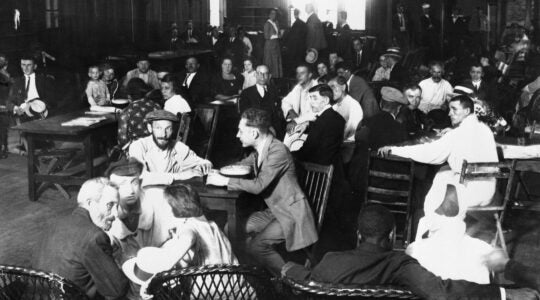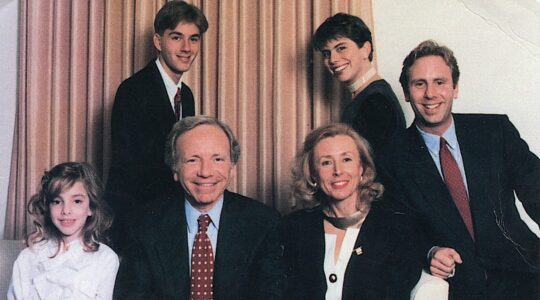TULSA, Okla. (JTA) — For millennia, the month of Elul has been a time for contemplation for many Jews. The waning of the prior year and the promise of a new beginning offer the perfect opportunity to take stock of where we have traveled and the road that lies ahead.
It was against this background of our tradition that I recently traveled to Kiev and, on my way home, found myself reflecting on the miraculous revival of Jewish life in the former Soviet Union, a transformation I have had the privilege of witnessing firsthand during the past two decades.
Fifteen years ago, the Jews of the former Soviet Union were just awakening from 70 years of oppression. The Communist regime prohibited the practice of Judaism, and those synagogues that were neither destroyed nor allowed to fall into ruin were put to use by the state for non-religious purposes.
Other than the JDC and Chabad, very few Jewish groups had any meaningful representation and programs in the region, and the mix of apprehension and ignorance among the local Jewish population made working there a very difficult task.
Despite these obstacles, Charles (z"l) and Lynn Schusterman considered the lifting of the Iron Curtain a window of opportunity that they simply could not afford to miss. They also felt there could be significant lessons to be learned about assimilation and the power of the Jewish experience from a people returning to Judaism from a deep, dark, government-imposed slumber.
And so, in 1994, our foundation joined with Hillel and the American Jewish Joint Distribution Committee to open Hillel programs in Moscow, St. Petersburg and Kiev. Our goals were to begin to plant the seeds of a vibrant Jewish community in the former Soviet Union and then, if we were successful, to discover what it is about Judaism that kept a yearning alive for so many. We hoped that answer would ultimately hold the key to Jewish renewal in the United States and elsewhere.
Today, what we and others sowed in the ’80s and ’90s have grown into fruit-bearing trees from which the local and global Jewish community will benefit for years to come. In addition to the 26 Hillels in the region, there are synagogues, Jewish community centers, chesedim (social service/welfare centers), kindergartens, day schools, camps, youth programs, academic groups, women groups and Taglit/Birthright Israel. Even local Jewish funders, including the Genesis Philanthropic Group, are supporting a variety of other projects in the region, including Hillel.
In short, it is no longer a stretch to talk in terms of Jewish communal life in places such as Kiev and Kharkov, Tashkent and Tblisi, Moscow and Minsk. Thanks to the efforts of many, a strong Jewish infrastructure now exists to support the Jews of these communities, especially those who still live on meager pensions and require our ongoing assistance.
Of course, our community-building work in the FSU is far from over. Even in these difficult economic times, we must continue to make long-term investments in the region in addition to meeting individual needs of the elderly and infirm or risk watching our hard-earned gains of the past 20 years slip away. We cannot afford to take an ‘either-or” approach; an “and-both” is our only alternative, and we must find ways to muster the resolve and the resources to make that happen.
And what of the lessons we hoped to learn?
We confirmed our sense that using Hillel to reach out, educate and empower young Jews would be an effective way to identify, recruit, train and engage a new generation of Jewish communal leadership, both lay and professional. Throughout the FSU, as well as in organizations in the United States and Israel that serve Russian-speaking populations, there are Jews like Dasha Privalko, who was a teenager when I met her on my first trip to Kiev and today, as an adult, is a senior member of the Hillel Ukraine team.
We were introduced to the power of service. Years before it was as fashionable as it is today, dozens of young Jews from inside and outside the FSU traveled throughout the region each spring to help lead Passover sederim. Jews who thought no one knew or cared about them shared an educational and emotional Jewish experience with young people who, in turn, received at least as much in return as those to whom they brought great joy.
We also were exposed to the value of providing young Jews from one region with opportunities to work alongside their peers from other communities and countries. This is a lesson that Taglit now employs so effectively to help strengthen Jewish identity.
Finally, the vitally important concept of "meeting people where they are" emerged from the earliest days of the FSU Hillel program and now has become the generally accepted approach to outreach in America. It took almost no time at all for us to realize that for Judaism to flourish anew in the FSU, especially among those young Jews for whom the post-Soviet lifestyle is all they have ever experienced, Jewish life in the region must be one of their own making.
It is at a time like this, one of reflection and rebirth, that we can draw inspiration from the revival of Jewish life in the former Soviet Union. It is a story that embodies the enduring values of our heritage, the remarkable resilience of our people and the unlimited potential of our future.
(Sandy Cardin is president of the Schusterman Family Foundation.)





